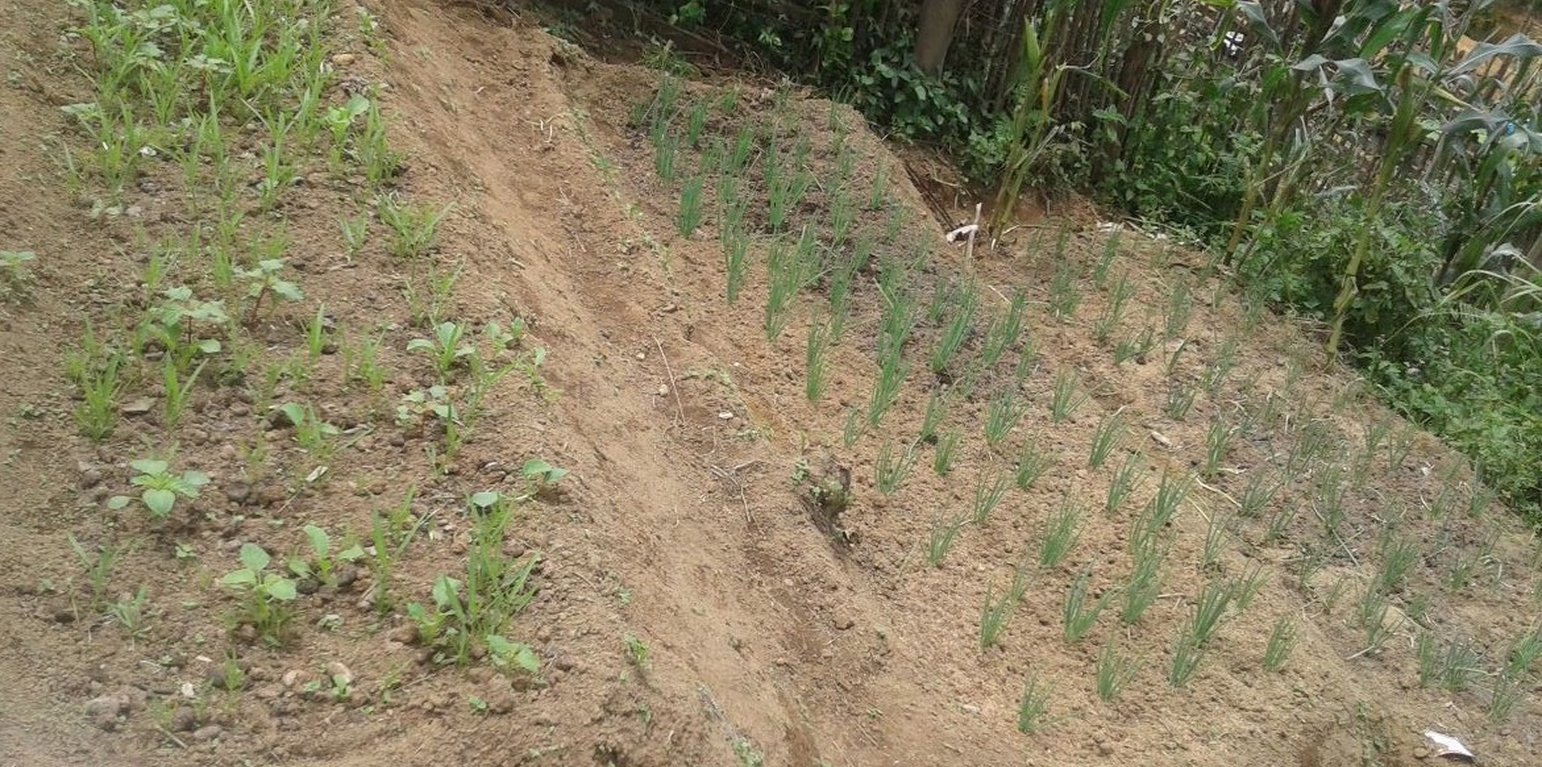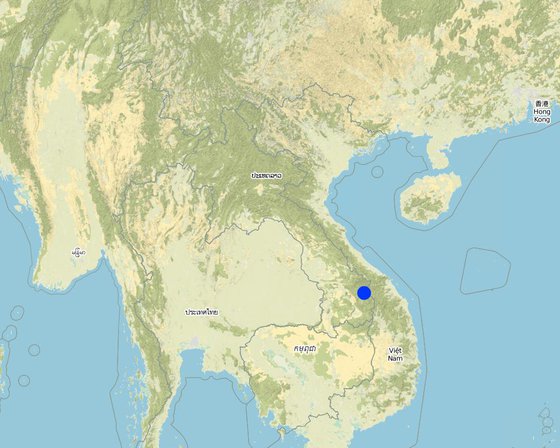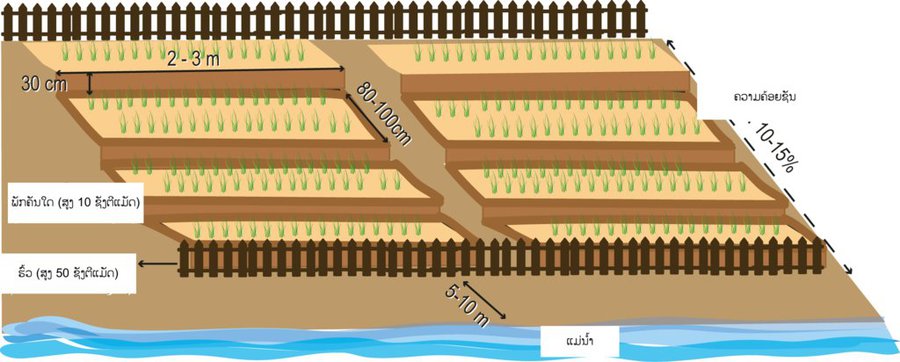



The local farmers mainly grow vegetables with other crops such as upland rice in upland areas and vegetable home gardens. In addition, they grow also vegetables along riverbanks during the dry season. Land users living on mountainous areas typically grow vegetables during the wet season and some manage to cultivate them during dry season if appropriate land is available along streams and river banks. Vegetables have traditionally been cultivated by farmers in Darkchung district on terraced fields for many generations. However, growing vegetables on areas of land with a higher gradient (rolling slopes: 11-15%) has a number of restrictions, namely the lack of suitable land available and the limited water supply. As a result of these restrictions on land and water farmers have developed their own initiatives to enable the cultivation of vegetables on sloping land both for household consumption and for sale. The vegetables most commonly grown are coriander, morning glory, and Chinese cabbage and mustard leaf. In 2000 farmers expanded their vegetable gardens on slopes by preparing and cultivating the land manually. Suitable land for such vegetable gardens can be selected along the lower banks of a stream (there should be a distance of approximately 5 – 10 meters from the river to the vegetable plots). Firstly, grass has to be removed prior to ploughing the soil manually. Then the soil from the top part of the land should be transferred to the bottom to result in a levelling effect so that a relatively flat garden bed is created. The preparation process to develop the whole garden takes about 3 – 4 weeks and requires a team of two to three people. In the preparation process there is a distinctive drawback when the farmers remove the humus and topsoil from the upper section of the field and leave the less fertile subsoil behind. As a result, this might affect the productivity during the early stage of vegetable growth; and on the contrary the lower sections piled with nutritious topsoil from the upper parts become more suitable for plant growth. To solve this problem, the farmers shape and level the nutrient-rich topsoil up to 3-4 small terraces top down. On average, with an area of 0.01ha such vegetable fields in Darkchung district are divided into small terraces with a width of 60 – 80 centimetres and a length of 2 – 3 metres (about 7 – 8 terraced plots per household, mostly two terrace arrangements in parallel). There is approximately a 30 cm difference between the levels of the upper to the next lower vegetable terrace. Once the land levelling has been completed, the farmers are then able to prepare the plots by firstly ploughing the soil and then letting it dry for 5 – 7 days. The next stage involves the use of wooden poles to break down bigger clods of earth. Then a small earth dike (10cm in hight) is pilled up around each terrace to protect furhter against soil erosion by water. Before starting the vegetable cultivation fencing is needed against animal entry. After this, they use a rake to adjust the plot’s surface. The benefits of this terracing method is to extend the cultivation of vegetables on stream river banks for the household consumption. Futhermore, the terracing method and the better soil cover lead to protection of the stream banks from erosion and sediment transport. However, this technique have some constraints as well beause it is difficult to level the surface of the soil in these areas particularly by removing soil from the upper sections to the lower sections of the terraces.

Location: Darkchung district, Xekong province, Lao People's Democratic Republic
No. of Technology sites analysed: 2-10 sites
Spread of the Technology: evenly spread over an area (approx. < 0.1 km2 (10 ha))
In a permanently protected area?:
Date of implementation: 10-50 years ago
Type of introduction






| Specify input | Unit | Quantity | Costs per Unit (LAK) | Total costs per input (LAK) | % of costs borne by land users |
| Labour | |||||
| Labour for land ploughing and levelling | person day | 21.0 | 30000.0 | 630000.0 | 100.0 |
| Labour for fencing | person day | 4.0 | 30000.0 | 120000.0 | 100.0 |
| Equipment | |||||
| Shovel | piece | 2.0 | 100000.0 | 200000.0 | 100.0 |
| Digger tool | piece | 2.0 | 100000.0 | 200000.0 | 100.0 |
| Construction material | |||||
| Nails | kg | 2.0 | 10000.0 | 20000.0 | 100.0 |
| Wire | roll | 2.0 | 60000.0 | 120000.0 | 100.0 |
| Wooden posts | piece | 80.0 | 5000.0 | 400000.0 | 100.0 |
| Wooden plank | piece | 20.0 | 5000.0 | 100000.0 | 100.0 |
| Bamboo | piece | 300.0 | 2000.0 | 600000.0 | 100.0 |
| Total costs for establishment of the Technology | 2'390'000.0 | ||||
| Total costs for establishment of the Technology in USD | 298.75 | ||||
| Specify input | Unit | Quantity | Costs per Unit (LAK) | Total costs per input (LAK) | % of costs borne by land users |
| Labour | |||||
| Labour for re-levelling the terraces | person day | 4.0 | 30000.0 | 120000.0 | 100.0 |
| Labour for weeding | person day | 3.0 | 30000.0 | 90000.0 | 100.0 |
| Labour to apply manure | person day | 1.0 | 30000.0 | 30000.0 | 100.0 |
| Labour for planting | person day | 3.0 | 30000.0 | 90000.0 | 100.0 |
| Plant material | |||||
| Seedling | bag | 4.0 | 5000.0 | 20000.0 | 100.0 |
| Fertilizers and biocides | |||||
| Manure | kg | 30.0 | 5000.0 | 150000.0 | 100.0 |
| Total costs for maintenance of the Technology | 500'000.0 | ||||
| Total costs for maintenance of the Technology in USD | 62.5 | ||||
Increase crop production
Lower risk of flooding compared to other areas of vegetable gardens located in the lower plains.
Increase and diversification of vegetable production from their own vegetable home gardens due to enlargement of production area.
Quantity before SLM: 0.02 ha
Quantity after SLM: 0.04 ha
As the land users use sloping land on river banks nearer to the village by shaping the land into terraces the land management for vegetable gardens has been simplified compared to the collection of wild vegetable on sloping forest area far away from the village.
Before the farmers mainly produced for their home consumption. After: The vegetable production increased substantially to a level it can be also sold at the local market.
The new option to sell vegetables at the local market diversified the income sources.
Workload decreased mainly for women as they do not have to spent time anymore to collect wild vegetables in the broad upland forest.
Women benefit from this technology and it reduces the women's workload to collect vegetable from forest.
Protect stream banks from soil erosion by rain water.
Increased vegetation cover by the vegetable plantation. Before it was fallow covered with scarce grass vegetation.
Less sediment transportation due to improved vegetation cover in the slope areas of the river banks.